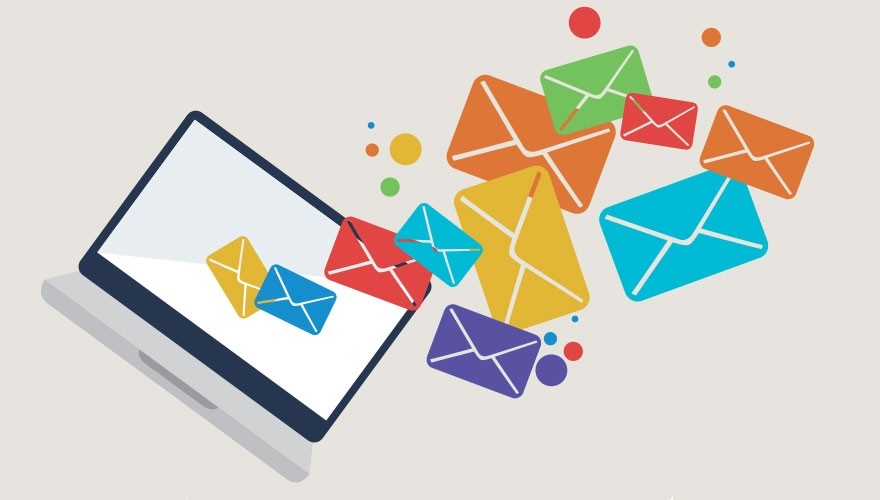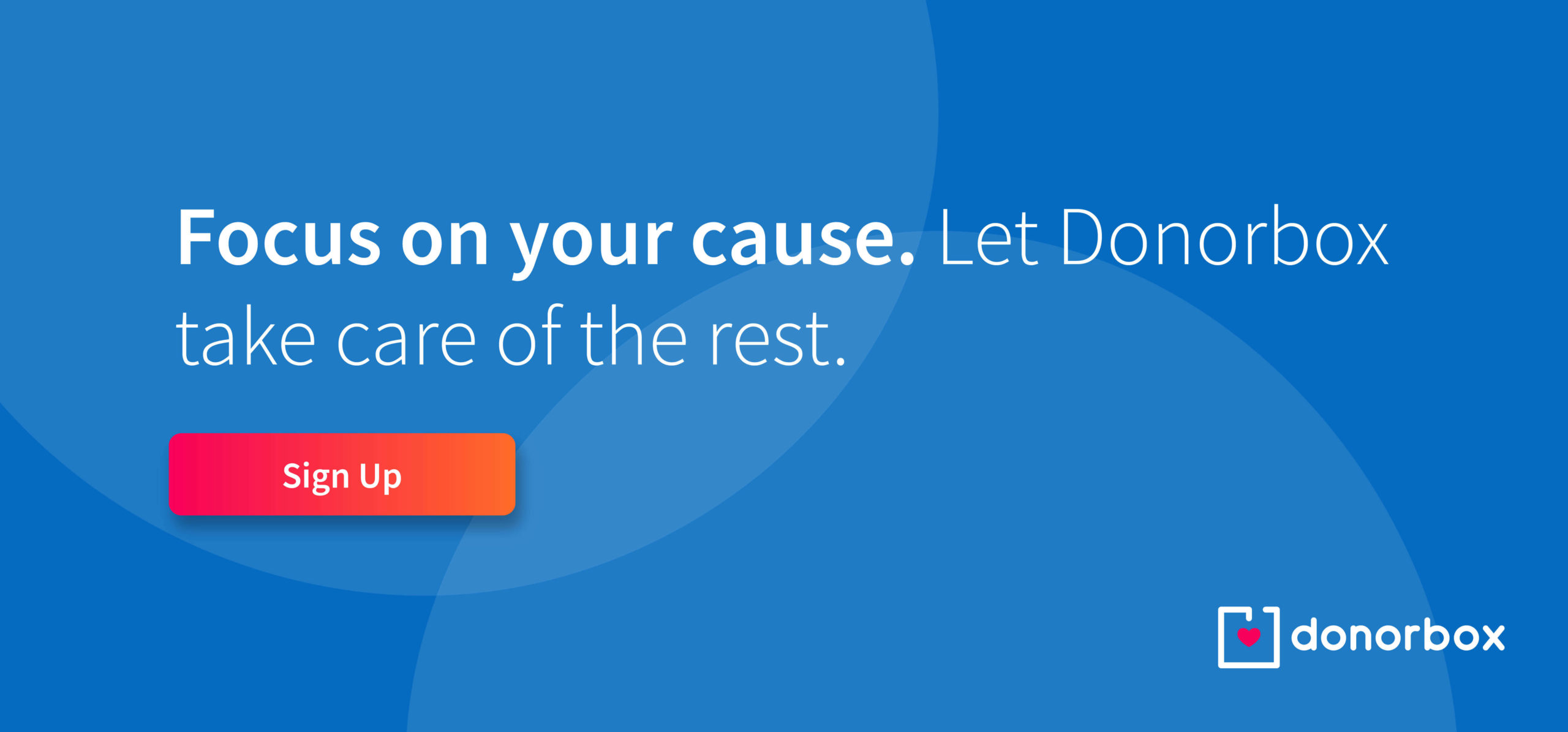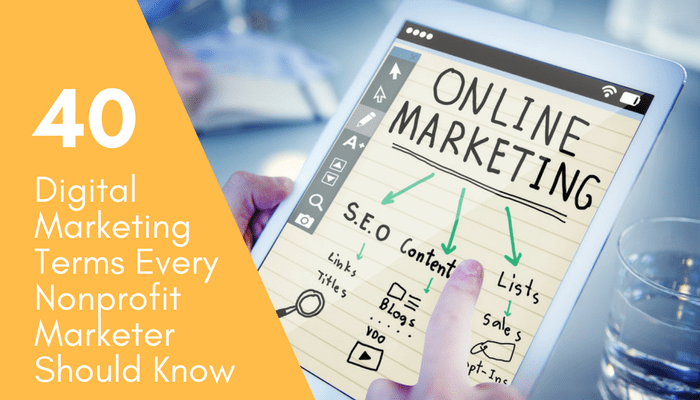Anyone who works in digital marketing knows it can be daunting to understand the complex vocabulary and acronyms that come with it. It can be difficult to keep up with all of the terms and slang used with the constant introduction of new technologies and platforms, so we decided to create a quick and simple digital marketing glossary for nonprofit marketers.
Getting familiar with these will help you navigate the world of digital marketing and further your nonprofit’s mission.
This is a living document that will continue to grow as we add more terms and expand our definitions.
We’ve divided the terms into four categories: Content Marketing, Email Marketing, Digital Marketing, and Social Media.
A. Content Marketing

1. Blog
Blogs began as online diaries or journals and are a combination of the words “web” and “log.” They have now turned into a powerful marketing tool for nonprofits and businesses alike.
Blogs are an important section of a website in digital content marketing. They offer fresh new content on a regular basis which can help attract new visitors and engage existing visitors. The posts are usually listed chronologically.
Here’s a step by step guide on how to create a successful nonprofit blog.
2. Brand Mention
Brand mentions are references to a company, brand or organization online. These are usually on social media or in a blog post, website article or another piece of content.
Mentions are usually in the context of complaints, reviews, customer conversations, and expert opinion articles.
Brand mentions can directly affect the online reputation of an organization, which is why it’s important to monitor them.
3. Content Marketing
Content marketing is the process of developing and sharing relevant, valuable, and engaging content to an organization’s target audience with the goal of acquiring new customers or increasing business from existing customers.
The content is often in the form of blog posts, infographics, or other visual content. The content offered should be relevant and useful. Content marketing seeks to attract customers or donors.
Content marketing has expanded into visual content marketing, that will notably affect non-profits. Visuals are effective in attracting donors and spreading awareness about non-profit activities. Some visuals that can be shared include photographs of non-profits in action, data visualization of industry statistics,
non-profit infographics, and videos of testimonials and donors.
4. Content Curation
Content curation is the act of finding, gathering, and presenting digital content that surrounds specific subject matter. Curating content is now becoming a marketing staple for many organizations with a successful online presence. Content curation does not include generating content, but instead, amassing content from a variety of sources, and delivering it in an organized manner.
5. EBook
An eBook is an electronic version of a book that can be read on a computer, tablet, or mobile phone. eBooks do not need to be the length of a traditional book. eBooks can be a great marketing tool for nonprofits to share best practices of a topic relevant to various shareholders.
Furthermore, by asking for visitor’s information to gain access to an eBook, an organization can develop leads. An ebook presents correctly formatted text and images no matter the size of the screen it’s being displayed on.
6. Editorial Calendar
An editorial calendar is a tool that is used by publishers, organizations, and bloggers to plan the creation, publication, and promotion of content across different media channels, such as blogs, email newsletters, social media and print articles.
An editorial calendar should be part of a larger content marketing strategy (see content marketing).
Many nonprofits that struggle with consistency have found an editorial calendar to be the perfect solution. A content marketing editorial calendar is essentially a planning document and can be as simple as having a Google Spreadsheet.
7. Guest Blogging
Guest blogging is generally used to gain access to larger audiences by writing posts for another organization. This type of blogging is also known as guest posting — is the practice of contributing a post to another person’s blog in order to build relationships, exposure, authority, and links. Links are a primary ranking factor in Google, and in SEO guest blogging offers a strong opportunity to secure a link back from another website.
However, excessive guest blogging or linking to your own website can result in penalizations by Google. To avoid that, find the right audience, write something unique, and don’t link back more than once.
8. Influencer
An influencer is a person who has a high level of impact on a specific area of interest. An influencer may be a journalist, celebrity, brand advocate, or a content creator (blogger, YouTuber) who has a positive impact on a consumer’s buying or product interest behavior.
For example, a Youtube video from a content creator with 10 million subscribers about a specific product will have huge gains for that business or organization. Nonprofits can utilize influencers to promote their cause or campaigns.
9. Keyword Research
Keyword research process refers to identifying search terms for a specific piece of content or website. Online tools exist to speed up this process by allowing marketers to search for related keywords and their relative search popularity.
SEO professionals use tools such as the Google Adwords Keyword Planner. The ultimate goal of keyword research is to identify keywords for use in content in order to increase search engine rankings.
Generally, phrases that most accurately describe specific qualities of a site yield the highest ROI.
10. Long Tail Keywords
Long tail keywords are multiple-word phrases that have lower search volume but often prove to be more qualified searches because whenever a customer uses a highly specific search phrase, they tend to be looking for exactly what they are actually going to buy.
An example of a long tail keyword phrase is “white porcelain minimal bathroom set” instead of “bathroom set.”
11. RSS
Rich Site Summary or Really Simple Syndication – or RSS – is a text-based format that delivers content from sites that are updated on a regular basis, such as news sites or blogs.
RSS feeds save the user time by eliminating the need to visit a site on a regular basis to check out the latest news and information by allowing a user to subscribe to feeds from multiple sites and review them in one convenient location. Users view an RSS feed through an RSS reader, the software that gathers and presents the content.
12. Thought Leadership
Thought leadership is the ability to access thought leaders and develop content based on their well-informed and highly-respected opinions.
Content created by thought leaders can also reach a much larger audience due to the influencer’s reach (think politicians, writers, scientists, journalists, experts in the field).
13. User-Generated Content
UGC for short, user-generated content describes any form of content such as video, blogs, forum posts, digital images, audio files, and other forms of media that were created by consumers and is publicly available to other end-users.
User-generated content is also called is any form of content generated by consumers for a brand. This form of word-of-mouth information can help move potential donors and volunteers through the funnel because user-generated content is often considered more authentic and trustworthy.
B. Email Marketing

14. Average Open Rate
An average open rate is a measure of how many email recipients open an email as compared to the total number of emails delivered within a campaign/time frame.
Otherwise, to determine an email open rate, first, subtract the total bounced emails from the total emails delivered. Then divide that number by the total emails opened. The average email open rate can vary based on the industry.
15. Bounced Email
Bounced email is an email that couldn’t be delivered to a recipient. Typically, it is a metric expressed as a percentage of subscribers who didn’t receive your message.
There are two types of bounces: hard and soft.
A hard bounce indicates a permanent delivery problem (such as an inactive or incorrect email address). A soft bounce indicates a temporary delivery problem (such as a full inbox or an email message that is too large).
16. Click Through Rate
CTR or click through rate is the measure of how many people clicked on a hyperlink, CTA (call to action) or image within a particular email.
It’s important to note that CTR is a somewhat variable number. If you had a 30% click-through rate, it would mean that for every 10 people who opened your email, three people went on to click a link within that campaign.
Email CTR depends not only on the subject lines (which affect email open rates) and calls to action. Other elements like link positioning, time of the day, email length, and link emphasis can impact the CTR rate.
17. Call To Action
A call-to-action (or CTA) is an image or line of text that prompts your visitors and leads to take action (usually subscribe, register, download, sign-up or donate).
Make your CTAs clear and simple, with an eye-catching design, a clear value proposition, a copy that makes people want to act, and its own landing page.
18. Email Conversion Rate
Email conversion rate measures whether the individual completed the action after clicking the link in your email. For nonprofits, this is usually signup or a donation. When developing any marketing campaign, it is important to have a clear call to action (see above) so as to lead to a conversion. The conversion point will depend on the goal of the marketing message.
19. Drip Campaign
A drip campaign is a method used in marketing to acquire customers through lead nurture programs. It involves sending marketing information to prospects repeatedly over long periods of time in order to lead them to a final conversion point.
They are usually pre-written, ongoing campaigns, that provide value to subscribers while also keeping the brand top-of-mind. They are called ‘drip campaigns’ because these emails slowly “drip” helpful information, products or tips over days, weeks or months.
20. Email A/B Testing
A/B testing, also known as split testing, is a way of finding out which of two email campaign options is the most effective in terms of opens or clicks.
In an A/B test, you set up two variations of the one campaign and send them to a small percentage of your total recipients. From there, the remaining subscribers would be sent the winning version.
21. Email Campaign
An email campaign is a coordinated set of email messages that are deployed across a specific period of time with one specific purpose, such as donate to mark a specific day or sign up for an event.
The individual emails are sent out at different times, and what differentiates them from any other email is that they are all purposely designed to achieve the same purpose. Email campaigns are often sent through email service providers, like MailChimp.
22. Email Marketing
Email marketing is a form of direct marketing that uses electronic mail as a means of communicating commercial or fundraising messages to an audience. It is, however, quite affordable, so it can generate quite a high return on investment (ROI).
Bonus: If you want to get the most out of your email campaigns, here’s a great resource on driving renewals with email campaigns.
23. List Hygiene
List hygiene refers to the process of periodically removing bounced email addresses and unengaged subscribers from your email subscribers list, and updating any email addresses change requests. It may also be helpful to periodically verify by a subscriber that they still want to receive messages from your nonprofit.
24. Lead Nurturing
In some ways similar to drip campaigns, lead nurturing is the process of establishing and maintaining relationships with possible customers.
The main difference between drip campaigns and lead nurturing is that in lead nurturing, emails or messages sent are more personalized as they are based on the individual activity and behavior of the user.
25. Opt-Out
Also known as ‘unsubscribe’, an opt-out is a request to be removed from an email deployment list for a specific group of messages, or all lists owned by the sender. Always include the opt-out link in your emails, and honor them as soon as possible.
C. Digital Marketing

26. Cost Per Click
Cost per click or CPC refers to an organization’s cost for each click an ad receives. A click is not unique to the person taking action. CPC is calculated by dividing the total amount spent on a campaign by the number of clicks generated.
27. Creative Commons
CC licenses allow the creator of the work to select how they want others to use the work (e.g. a photo or a video). When a creator releases their work under a CC license, members of the public know what they can and can’t do with the work.
28. Embedding
Embedding is the act of adding code to a website so that a video or photo can be displayed while it’s being hosted at another site.
29. Google Adwords
Google’s own advertising service, Google Adwords allow you to place search results for your website on a search engine results page (SERP) by paying for them. Google looks at how relevant and useful your ad is to the searcher and the search terms they’ve used.
It also looks at how many clicks your ad has received previously, also known as its click-through rate (CTR) and how relevant your landing page is. You pay Google AdWords each time your ad is clicked. The price you’re willing to pay for each click is called cost-per-click (CPC).
30. Landing Page
A landing page is the first page that a visitor sees when they land on your site, regardless of how they got there. This doesn’t have to be the home page. Organizations often build landing pages for targeted audiences. Landing pages often contain a clear call to action. They usually include a form for the visitor to fill out and the organization then uses the contact information to reach out later.
31. Meta Tags
A meta tag describes the content on a webpage. Meta tags, such as the meta title and meta description keywords and phrases that describe a page’s content. Without meta tags, websites will not be properly indexed or showcased to users in search engines. This makes them very important for an organization’s SEO plan.
32. Persona
A persona is usually detailed profile of a buyer, donor or beneficiary that represents a segment of an organization’s target audience. The persona profile includes some fiction, such as a specific
name and age, but other characteristics are based on real qualities of your donors. Most organizations will have more than one donor persona.
33. SEO
SEO, also known as “Search Engine Optimization,” is the marketing tactic used to increase a website’s visibility within search engines like Google, Bing, and Yahoo! The higher a website ranks (or the more visible it is) within a search engine, the more traffic and brand awareness hey will receive.
The SEO process encompasses factors like quality content around specific topics, clean site architecture, authority and trust of the website, and so on.
34. User Experience
The exact definition, as outlined by the International Organization for Standardization, is a “person’s perceptions and responses resulting from the use and or anticipated use of a product, system or service.” User experience (UX) is how an individual feels about every interaction they have with a system. The system could be a website, a web application or desktop software and, in modern contexts, is generally denoted by some form of human-computer interaction (HCI).
35. Viral Marketing
Generally speaking, the goal of a viral marketing campaign is to raise brand awareness. Consequently, viral marketing is about reaching out and touching your consumer so that their passion and excitement drives the message and the message continues to reach the masses without assistance from you.
Unlike word-of-mouth marketing, it has a compounding effect.
36. Word-of-Mouth marketing
With word-of-mouth marketing, the consumer shares their experience with your programs or services, and they share it with their family and friends. Many small nonprofits find word-of-mouth marketing to be crucial during their early stages.
D. Social Media

37. Engagement
This refers to when a visitor interacts with the content, most often on social media. Therefore, engagement includes commenting, sharing, “liking,” linking, and other activities.
38. Favorite
Favorite is when a Twitter user clicks on the star, so it is the equivalent of “liking” content on Facebook.
39. Feed
The social media data format that provides users with a steady stream of updates and information.
40. Hashtag
Hashtags are a word or phrase (preceded by the # symbol) included in a post to help make it easy to find and group with related posts. Hashtags are most often used on social media, and most frequently on Twitter.
Have more terms to add? Any comments on the above? Let us know via Twitter or Facebook.
Need some help with any or all of the above at your organization? That’s what we do at Donorbox Nonprofit Blog!








